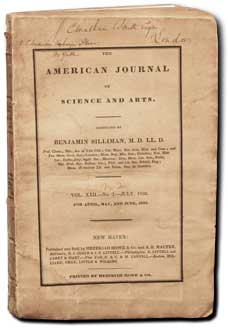| Contact |
| Back | Next | Home |
The
Foundations of Induction
-
1826
Joseph Henry (1797 -
1878)
|
|
Joseph Henry’s discovery of self
induction in 1832 was the
first appearance of a major US discovery in
electricity since Benjamin Franklin.
Writes Henry: "I may however mention one fact which I have not seen noticed in any work ...when a small battery is moderately excited... if a wire thirty or forty feet long be used instead of the short wire, though no spark will be perceptible when the
|
|
connection is made, yet when it is broken by
drawing one end of the wire from its cup of mercury, a vivid spark is
produced."
In these words Henry reported his observation of self
induction, two years before Faraday and a few months after Faraday's
seminal paper on mutual induction (which Henry acknowledges). The unit of
inductance was subsequently called "Henry", and that of capacity, "Farad",
after Faraday.
It is this
paper, not the 1834 paper referenced in Dibner 65, that describes the
discovery of self-induction. Faraday reported self induction later, in
Dec. 1834, (Exp Res, 1048). Wittaker attributes the discovery of self
induction to Faraday (Exp. Res. 1048) but adds: " A similar observation
had been made by Joseph Henry, and published in the Amer. Jour. Sci. xxii
(1832), p. 408,"
Relevant to the controversy between Faraday and Henry
is the following statement by A D Bache, Secretary of the American
Philosophical Society introducing an abstract of Henry in J Franklyn Inst.
1835 pp. 169-70 (H. Norman 1053): "A memoir on this subject has been since
submitted to the Society, containing an extension of the subject, the
primary fact in relation to which was observed by Professor Henry as early
as 1832, and announced by him in the American Journal of Science. Mr.
Faraday having recently entered upon a similar train of observations, the
immediate publication of the accompanying is important, that the prior
claims of our fellow countryman may not be overlooked."
This is an
extremely rare publication in this condition.
| Contact |
| Back | Next | Home |
